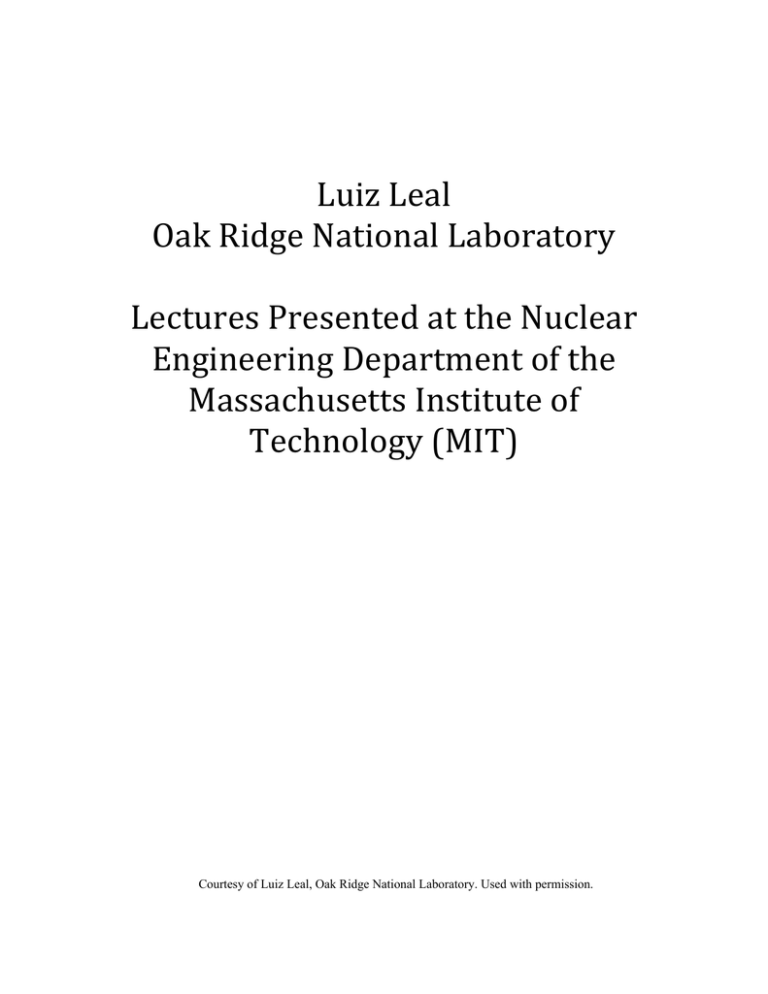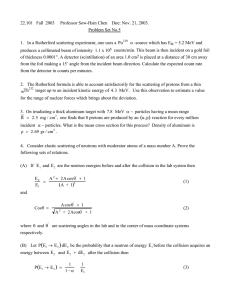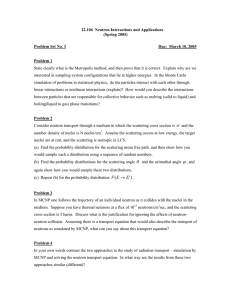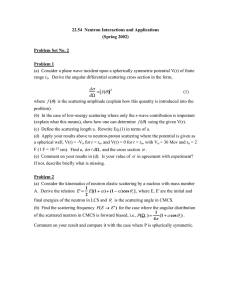Luiz Leal Oak Ridge National Laboratory Le
advertisement

Luiz Leal Oak Ridge National Laboratory Lectures Presented at the Nuclear Engineering Department of the Massachusetts Institute of Technology (MIT) Courtesy of Luiz Leal, Oak Ridge National Laboratory. Used with permission. Thermal Neutron Scattering Kernel Development The procedure consists of finding the amplitude of the scattering wave function that leads to the differential scattering cross section. In doing so, a few things will be assumed: (1) First Born approximation; (2) Fermi Pseudo‐potential; (3) Time‐dependent Schrödinger equation (TDSE) The first two assumptions have already been discussed. Why assume the TDSE is explained as follows: the energy dependency (explicitly) in the Schrödinger equation implies that the eigenstates of the scattering system are known, i.e., initials and final states. Usually they are not known and even if they are known there will a large number. It is desired to “eliminate” the explicit appearance of the eigenstates. In so doing one uses ∂ψ E → i ∂t or 2 2 ∂ψ ∇ + V ψ = i − ∂t 2m Leo Van Hove championed this idea. The time dependence is subsequently used in a Fourier transformation. Assuming that the interaction occurred at t = t 0 . The wave function at the detector at the € position r for t > t 0 is a solution of the equation € € € 2 2 ∂ψ ( r , t) ∇ + V (r , t)ψ (r ,t) = i − ∂t € 2m € For t < t 0 before the collision has occurred the incident‐neutron wave function is i(k .r − w 0 t ) ψ inc (r , t) = e where k → neutron momentum w 0 → neutron energy The solution at the detector at (r ,t) is ! ! ! " ( r ,t) = " inc ( r ,t) + " scat (r ,t) € Given that for the incident wave from the potential region € ψ inc away 2 2 ∂ψ ( r ,t) ∇ + i ψ inc (r ,t) = 0 ∂t 2m then 2 2 ∂ψ ( r ,t) ∇ + i ψ scat (r ,t) = V ( r ,t)ψ ( r ,t) ∂t 2m € Approximations: € (a) Born approximation In the right‐hand side of the above equation: ψ ( r , t ) → ψ inc ( r , t ) (b) Fermi Pseudo‐potential 2π 2 anδ[r − Rn (t)] Vn (r , t) = m where Rn → position of nucleus n at time t an → bound scattering related to the bound cross sec tion as σ b = 4πan2 (an2 = σb ) 4π Hence the equation to be solved is € 2 2 mi ∂ a ( ,t) (r , ∇ + ψ t) = 4 π δ [(r − R (t )] ψ r ∑ scat n n 0 inc ∂t n € € Note that Rn (t 0 ) is for reactions that occurred at the t = t 0 . Making use of the Green’s function method to € solve the equation above. Let G(r − r ',t − t 0 ) be the Green’s function, hence: 2 2 mi ∂ € ' ∇ + ∂t G(r − r ,t − t 0 ) = 4 πδ (r − r ')δ (t − t 0 ) The solution for ψ scat (r, t) is ψ scat (r , t) = ∫ ∫ dτ dt0G(r − r ',t − t0 )ψ inc (r ',t0 )∑ anδ[r − Rn (t0 )] τ t0 € € € € € € n where τ is the volume. G(r − r ',t − t 0 ) and Substituting the values for ψ inc we have m t 3/2 ψ scat ( r , t) = i dt 0 (t − t 0 ) ∑ an ∫ dτ δ[r − Rn (t 0 )] × € ∫ 2π −∞ n im r − r ' 2 × exp[i(k 0 .r − w 0 t)] exp 2 (t − t 0 ) The above expression is the solution for the scattered wave ψ scat at the detector at the position r for the time t > t 0 for an incident neutron of energy w 0 and momentum k0 . It is not clear how to obtain the scattered amplitude from th €e above equation. Leon Van Hove came up with a cle€aver idea of u€sing a Fourier € transform of the type ' iw' t ψ scat ( r , t) = ∑ f (r , w )e w' and T ∫ dt e ψscat (r, t) 1 f (r , w') = T € € € f (r, w) iw' t 0 relates to the scattered wave amplitude. After LOTS OF ALGEBRA 1 f (r , w') = Tr' T ∫ dt 0 0 e iw' t 0 iκ . r ∑ an ∫ dτδ[r − Rn (t0 )]e n For derivation of the above equation see: Thermal Neutron Scattering by Engelstaff pages 49‐52 The scattered neutron has κ = k0 − k → momentum change w'= w 0 − w → energy change The scattering differential cross section is defined as € d 2σ 2 2 T υ = r' f (r ,w) dEdΩ h υ0 υ 0 and υ initial and final neutron velocity € Read: The Elements of Neutron Interaction Theory Anthony Foderaro page 555 2 f (r ,w) = 1 +∞ iκ .( r − r ") − iwτ * dτ e ∑ am an ∫ dr " ∫ dr e × 2 2 ∫ T r' −∞ m,n δ[r " −Rn (0)]δ[r − Rn (τ )] The bar indicates time averaging. € The double differential cross section is finally obtained as d 2σ 1 υ +∞ iκ .r −iwτ * = dτ e am an ∫ dr ' ∫ dr e × ∑ ∫ dEdΩ h υ 0 −∞ m,n δ[r " − Rn (0) − r ]δ[r − Rn (τ )] € The Space­Time Correlation Function (Van Hove) 1 G(r , τ ) = ∑ ∫ dr'δ[r ' −Rn (0) − r ]δ[r − Rn (τ )] N m,n G( r , τ ) is not the Green' s function!! € € € G(r ,τ ) Interpretation of the Two parts: € for m = n (diagonal terms) Gs ( r , τ ) for m ≠ n (off‐diagonal terms) Gd (r , τ ) € € Interpretation: Gs (r , τ ) → self − correlation function : a second IDENTICAL nucleus is present € € € € € Gd ( r , τ ) → distinct − correlation function : second DISTINCT nucleus is present G ( r , τ ) = Gs ( r , τ ) + Gd ( r , τ ) where a N 1 Gs (r , τ ) = ∑ ∫ dr'δ[r ' −Rn (0) − r ]δ[r − Rn (τ )] N n=1 and N 1 dr'δ[r ' −Rn (0) − r ]δ[ r − Rn (τ )] Gd (r , τ ) = ∑ ∫ N m≠n=1 Defining 1 < a >= ∑ a*m anδmn N m,n 2 < a >2 = d 2σ d 2σ coh d 2σ incoh = + dEdΩ dEdΩ dEdΩ € € € 1 * a ∑ m an 2 N m≠n Assuming only coherent inelastic scattering present, i.e., < a 2 >=< a > 2 = a d 2σ d 2σ coh = € dEdΩ dEdΩ d 2σ a2 υ = dEdΩ h υ 0 Recall that ∫ i(κ .r −w' τ ) G(r , τ ) ∫ dr dτ e € € σb a = 4π and 2 υ = υ0 E E0 d 2σ σb = dEdΩ 4 π E ˜ S (κ,w') E0 w h e re 1 i( κ ˜S (κ, w ') = ∫ ∫ dr dτ e .r −w'τ )G(r, τ ) h ˜S (κ, w') → Scattering Law ˜S (κ, w') can be obtained directly from d 2σ measurements of dEdΩ ˜ Properties of S (κ ,w') (a) Depends only on the dynamics of the scatter center € (b) Sum ruler κ ˜ ∫ w S(κ,w) dw = 2M 2 (c) Condition derived from the detailed balance ˜S (−κ,w−) = e − w KT ˜S (κ,w) € € € Definitions: β 2 ˜S (κ,w) = e S(α, β ) − Where 2κ 2 α= 2mAKT E − E0 β= KT and Since 2 2 2 κ = k0 − k → κ = k0 + k − 2k 0 . k cosθ κ (k + k − 2k 0 . k cosθ ) α= = 2mAKT 2mAKT E 0 + E − 2 EE 0 cosθ ) α= AKT 2 2 2 2 0 2 Hence the double differential cross section becomes 2 dσ σb = dEdΩ 4 πKT β 2 E e S(α , β ) E0 − Notations: d 2σ dEdΩ or σ s (E 0 → E,θ ) or σ s (E 0 → E, µ) where µ = cosθ € Simple Example: (1) Scatterer is a single nucleus of mass M. Only coherent scattering is accounted for; (2) Scatterer is free and at rest This corresponds to the situation dealt with in the theory of neutron moderation where the chemical region effects are negligible. σb σ s (E 0 → E, µ) = 4π µ = cosθ E ˜ S (κ ,w) E0 ˜S (κ, w') is a delta function as 1/ 2 + − 2 (EE E E ) µ 0 ˜S (κ,w) = δ ( E 0 − E + 0 ) A M µ = cosθ and A = m Recall that w → E 0 − E 2κ 2 E 0 + E − 2(EE 0 )1/ 2 µ → 2M A Also, dΩ = 2π sin θ dθ µ = cosθ dµ = −sin θ dθ dΩ = 2π (−dµ) and σ s (E 0 → E) = ∫ σ (E s 0 → E, µ) dΩ 4π −1 σ s (E 0 → E) = 2π ∫ σ s (E 0 → E, µ) dµ +1 1/ 2 σ E σ s (E 0 → E) = 2π b 4π E 0 € −1 E 0 + E − 2(EE 0 )1/ 2 µ )dµ ∫ δ (E 0 − E + A +1 Change of variables E 0 + E − 2(EE 0 )1/ 2 µ x = E0 − E + A such that 2(EE 0 )1/ 2 dx = − dµ A € (E E ) µ = ±1 → x = E 0 − E + A 1/ 2 0 1/ 2 2 1/ 2 σb E A σ s (E 0 → E) = 2π 4 π E 0 2(E 0 E)1/ 2 σb A σ s (E 0 → E) = 4 E0 Recall that 2 A + 1 σb = σ free A x+ ∫ δ(x)dx x− 2 ( A + 1) 1 σ s (E 0 → E) = σ free 4 A E0 A −1 if α = A + 1 hence 2 4A → 1− α = 2 (A + 1) 1 σ s (E 0 → E) = σ free (1− α )E 0 Energy 2 range? A + 2Aµ + 1 E= E0 2 (A + 1) µ = 1 → E = E0 µ = −1 → E = (1− α )E 0 1 (1− α )E σ free 0 σ s (E 0 → E) = 0 for (1− α )E 0 < E < E 0 otherwise (Nuclear Reactor Analysis Duderstadt and Hamilton page 44) € MIT OpenCourseWare http://ocw.mit.edu 22.106 Neutron Interactions and Applications Spring 2010 For information about citing these materials or our Terms of Use, visit: http://ocw.mit.edu/terms.







